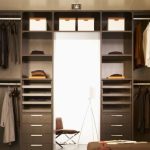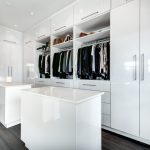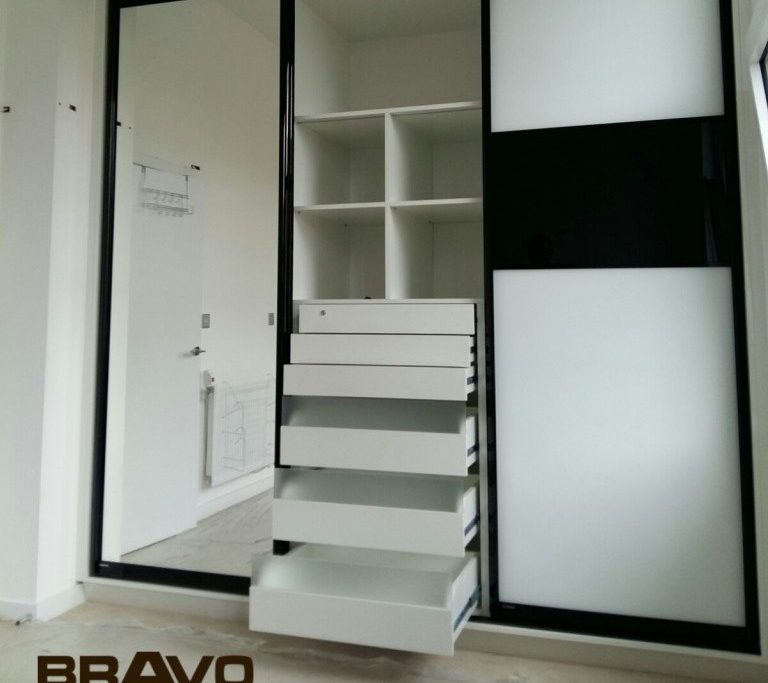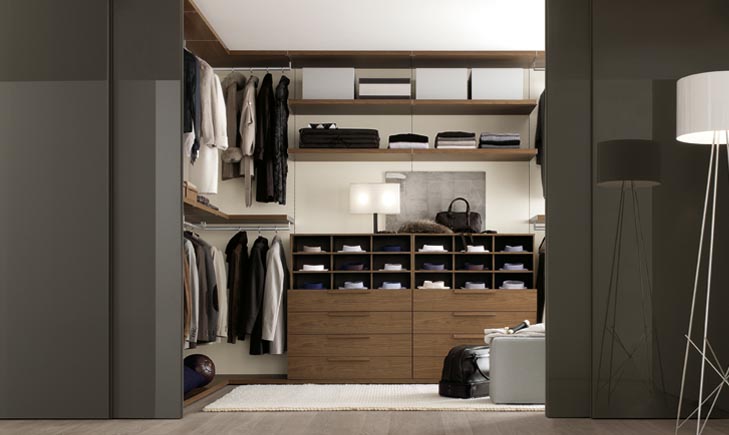Sliding Door Wardrobe Tips
How to choose a sliding door wardrobe: tips before buying.
Finding a place to store things in the house requires a balanced and responsible approach.

Finding a place to store things in the house requires a balanced and responsible approach. A separate dressing room can be arranged only in a spacious room, as this will require at least 3 sq. meters. For most apartments, such a decision would be irrational. Spacious and functional sliding wardrobes come to the rescue. There are so many options on the market today that you can easily get lost in the variety of materials, designs, interior. Let’s not forget about the bespoke made-to-measure furniture too. Therefore, we will lay out everything on the shelves and find out the important nuances that should be considered when buying. Here, we outline essential sliding door wardrobe tips to get you started!
The sizes of sliding wardrobes
The calculation of the sizes of a sliding wardrobe is based on the area of the room, and also quantity of things which need to be placed inside. We will consider standard dimensions. The 3 main parameters when designing a product are:
Height
Limited only to the height of the ceiling. Usually ranges from 2400 to 2600 mm: so you will be comfortable to get things from the top shelves. In high models (3 meters or more) a false box is made at the top or the filling is combined from several parts with the help of connecting profiles.
For proper operation of the sliding system, you must take into account the manufacturer’s recommendations for maximum height and weight of the door.
Width
Depends on the number of doors and is limited only by the length of the guide (3-5 m). The most popular 2-, 3- and 4-door models. The optimum sizes of doors of a sliding wardrobe – 600-900 mm on width. Too wide can be deformed, and narrow – to be not stable enough and fall out of the guide.
Depth
It varies from 300 to 800 mm, the standard value is 600 mm. If the case is shallow, instead of the usual longitudinal bar inside establish the microlifts extending perpendicularly to a facade.
Types of sliding door wardrobes: which one to choose?
Given the layout and area of the room, you need to determine the type of construction. The sliding wardrobe happens:
Built-in
This type is suitable for rooms where there is a niche or recess. The function of the rear and side walls is performed by the walls of the room. Rods and shelves are attached directly to them. Such models often do not have a separate roof and bottom. You will use every square centimeter of space, but keep in mind that the design will be completely stationary.
Free-standing
Unlike built-in, it is an independent piece of furniture that can be moved. It can be a straight (linear), radial or angular sliding wardrobe. The latter, in turn, can be added or trapezoidal.

Materials and accessories
High-quality components are a guarantee that the furniture will last a long time.
Carcass
The most common option is a housing with chipboard 16 or 18 mm thick. Slabs are affordable, easy to handle, and their surface mimics the appearance and structure of wood and other materials.
Importantly! Due to the peculiarities of the production of particleboard, it is necessary to pay attention to the emission class of formaldehyde. It is recommended to choose boards with class E0 and E1.
MDF has similar properties, but this board is more environmentally friendly, has increased strength and resistance to moisture. Due to the dense structure it is resistant to deformation. Formaldehyde resins are not used in the production of the material, so it is safe for health.
Particleboard, MDF and other materials are the basis for the production of veneered boards, which are becoming increasingly popular. A thin slice of wood (oak, walnut, ash), applied to the base, retains its natural texture, pattern and color. Veneer products are environmentally friendly, easy to care for and have a unique design: there are no identical trees in nature, so the pattern on each leaf is unique. At the same time, veneer furniture is more affordable than solid wood. Let’s move on to some more sliding door wardrobe tips.
Filling of sliding system
The following materials and their combinations are used for facades:
Mirror
A practical solution for small rooms and hallways. There are different types of artistic processing: removal of amalgam, sandblasting, faceting, etc. To prevent damage to the surface, a protective film is applied to the mirror.
Glass
Thanks to a variety of finishing options (artistic matting, photo printing, application of Oracal colour film) glass filling is universal and is suitable for an interior in any style. Textured glass looks original.
Wooden boards
The best and inexpensive option is facades made of chipboard (mostly 6-12 mm thick). Also the door cloth is made of MDF with the laminated, veneered, acrylic covering.
Among other options – rattan, bamboo, artificial leather, plastic. Combined facades with several types of fillings will make the design exclusive.
Door opening mechanisms
Why do we choose sliding door wardrobes more often than hinged-door options? The main advantages are facades that do not require additional space in front to open, and silent operation in the presence of stoppers and soft-closers. Mechanisms are sliding and complex (work on the principle of “accordion”).
The first, in turn, are divided into:
Lower support
The simplest and budget option. All the load falls on the lower guide. Such sliding systems are 1- and 2-track. In the first case, only 1 door is installed, which closes half of the section.
Upper support
This option is more complicated and expensive. The upper running profile is mounted on the roof of the cabinet. Facades are hung on it and at the same time are fixed on the lower guide. They completely hide the fittings, and the finished product looks aesthetically pleasing and neat.
Coplanar
Their main advantage is a perfectly flat facade. The door is mounted on the upper running profile and in the closed position are located in one plane. Such systems already belong to the premium segment.
The basis of each of the described structures are profiles of different configurations (horizontal, vertical, connecting, handle profiles), made of aluminum or steel. Aluminum is lighter and quieter in operation, are anodized, not anodized (for painting), with PVC film. Steel is more durable and long lasting. The surface can be chrome-plated, nickel-plated, with a polymer coating.
The rollers move the sliding doors. The most affordable are made of plastic, more expensive and reliable – of metal. Each model is designed for a specific load. To reduce noise and vibration, the lunch is covered with rubber or wear-resistant plastic (more resistant to abrasion). Pay attention to the presence of bearings: they guarantee a quiet, smooth ride. They are always on the lower rollers, and the upper ones can be without bearings. The number of rollers depends on the weight of the canvas: if it does not exceed 60 kg, you can limit yourself to two.
Also for installation of sliding system stoppers, buffer brushes and various fastenings (i.e soft-closers) will be required. For your convenience, accessories are often sold in sets. Only the assembly is on you!
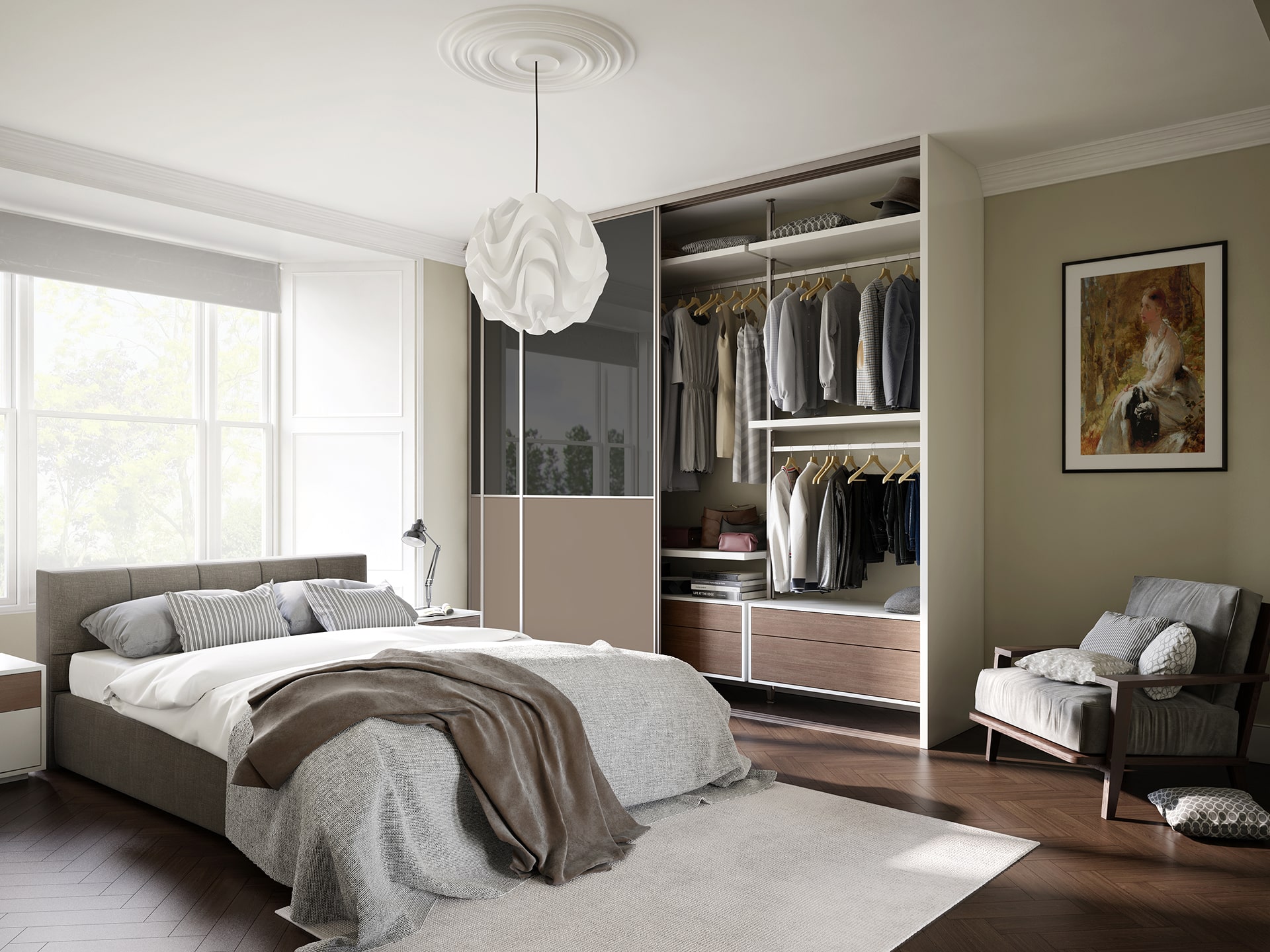
Internal filling. Sliding door wardrobe tips
These are the components that make it capacious and help organize the content. Consider the basic elements:
Rods for clothes on shoulders;
Microlifts (sliding bars, used to save space in narrow cabinets);
Pantographs (mechanisms with a handle, lower and raise the bar, allow you to fully use the upper tier);
Sliding and hinged shelves (for clothes, shoes, accessories);
Trousers, holders for belts and ties;
Baskets and cargo;
Sliding ironing boards, etc.
Tip: the backlight simplifies the search for the necessary things and gives the furniture a refined look. A practical solution would be touch switches, for example, on opening.
How to choose a sliding door wardrobe for the type of room?
Each room has its own purpose, and this affects the choice of furniture, their design features, size and content.
How to choose a sliding door wardrobe in the living room
This is usually the most spacious room, and it stores a variety of things: clothes, books, accessories. The decisive factor will be the capacity and availability of open sections for photo frames, souvenirs and other small items. It is also possible to equip the closing section for the TV or the computer (if the drawing room is combined with an office). With the help of a closet the room is easily divided into functional zones. Popular options are corner cabinets for the living room and wall-to-wall construction (even 4 meters long!): No dust accumulates in the corners, and everything you need is placed inside.
How to choose a sliding door wardrobe in the bedroom
The functional solution is angular or built-in structures. Usually there is no room in the bedroom for a large wardrobe, so a length of 2 meters or less will be enough. In addition, outerwear and shoes are stored in the hallway. Carefully consider the filling of the wardrobe: there should be mezzanines for bed linen, many pull-out shelves, drawers and baskets, and if possible – even a folding ironing board.
How to choose a sliding door wardrobe for the hallway
The main requirement is enough space for outerwear and shoes. In addition, there is a special compartment for umbrellas, hats and more. For the most efficient use of space, choose corner or built-in models. A mirror is often used to fill a sliding door wardrobe in the hallway, as the room is narrow and poorly lit.
How to choose a sliding door wardrobe for a nursery
Here a lot is decided by the strength and safety of components. Fittings must withstand significant loads, and materials – to be environmentally friendly (particleboard only with low emissions). Prerequisite – the absence of sharp parts and parts that the child can get caught. It is best to avoid glass and mirrors. At the same time, the design of facades requires imagination and bright details. Frequently used items are recommended to be placed on the shelves of the lower tier, the bar with clothes – at a height of not more than 80 cm. It is important to provide the ability to adjust its height, because the child grows.
Top 5 items that everyone should know before buying
The door should move smoothly and quietly, so pay special attention to profiles and rollers.
Mirror or glossy filling will visually expand the room, make it brighter.
Smooth flooring is the key to good and long-lasting operation of the door mechanism. If the floor is uneven, install special substrates.
Pick up materials to match the walls, and the cabinet will “merge” with them and become invisible. This solution is optimal for living rooms with large cabinets.
To use all the free space, choose built-in models. Order a Bespoke Wardrobe and get a product that will fit perfectly into your interior.
We summarize
When buying or ordering, be guided by your needs, the number of things you need to store, and the specifics of the room. Prefer durable and environmentally friendly materials, functional and quiet fittings. If you choose a new sliding door wardrobe instead of the old one, think about what did not suit you in the previous version: height, number of shelves, lack of lighting. Take these sliding door wardrobe tips into account, and let the furniture delight you with its capacity and unique design!




